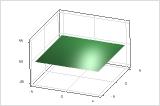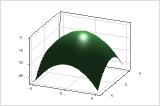To create an experiment with 2 or more continuous factors, 2-level factorial designs are common. To create a 2-level factorial design, select Estimate main and interaction effects when all factors have two levels.
Consider whether you need 1 of 2 types of designs for more specific cases. One case is a hard-to-change factor. If you have a hard-to-change factor, select Estimate main and interaction effects when all factors have two levels, and one is hard to change or Estimate main and interaction effects when some factors are hard to change. The visible option depends on the number of factors to study.
The other case is an experiment that estimates quadratic effects. Often, a 2-level design precedes an experiment to estimate quadratic effects because the estimation of quadratic effects requires more data. To estimate quadratic effects, select Estimate main, interaction and quadratic effects.
Decision details
The following information defines, main effects, interaction effects, a hard-to-change factor, and quadratic effects.
- What is a main effect?
- A main effect is an estimate of the effect of a single factor. For example, fertilizer company B is comparing the plant growth rate measured in plants treated with their product compared to plants treated by company A's fertilizer. In the experiment, fertilizer B has a higher plant growth rate mean than fertilizer A. The difference in the means is the main effect of the fertilizer factor.
- What is an interaction effect?
- An interaction effect is an estimate of the way that the effect of one factor depends on the value of one or more other factors. For example, if the levels are wide enough, the effect of time on the quality of a baked product depends on temperature. When the temperature is so low that the product is under cooked, then an increase in time increases the quality. When the temperature is in an acceptable range, an increase in time decreases the quality because the product burns. The effect of time depends on the value of temperature.
- What is a hard-to-change factor?
- A hard-to-change factor is a factor that is difficult to randomize completely because of time or cost constraints. For example, temperature is a common hard-to-change factor because adjusting temperature often requires significant time to stabilize. A split-plot design is a designed experiment that includes at least one hard-to-change factor. In a split-plot experiment, levels of the hard-to-change factor are held constant for several experimental runs.
- What are quadratic effects?
- A quadratic effect is a term that allows the effect of a continuous factor
on the response to change depending on the level of the factor. For example,
if the levels are wide enough, the effect of temperature on the quality of a
baked product is quadratic. When the temperature is so low that the product
is under cooked, then an increase in temperature increases the quality. When
the temperature is in an acceptable range, an increase in temperature
decreases the quality because the product burns. The effect of temperature
depends on the value of temperature.

Response surface with no quadratic effects

Response surface with quadratic effects
